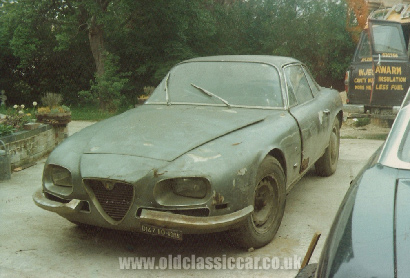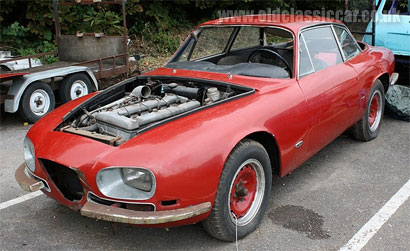John's Alfa Romeo 2600 Zagato.
There aren't enough classic Italian cars on the site for my liking, so it was really interesting to hear from John and news of his latest Alfa Romeo restoration project. No ordinary Alfa either, but a prototype 2600 with coachwork by Italian styling house Zagato no less. John takes up the story so far ..
|

|
History of this classic Alfa Romeo.
On a few occasions recently my wife has told people - generally men, and generally Alfisti - that I own an Alfa 2600 Zagato. Their reaction has, without fail, been the same. They smile politely, and say: "No he doesn't".
|
|
Believe me, I was as surprised as the next man to be surfing the internet one day, tapping various Alfa related terms into Google (as we Alfisti are prone to do) when I came across one for sale a stone's throw from Oxford. I rang the seller and a few days later drove down to see the car, and a short time afterwards texted my wife a single word: ‘Oops’. I left as the new owner.
|
|
Keeping with a tradition that still remains today, in 1961 Zagato were given a number of 2600 Sprint chassis when that car started production, and expected to perform their development magic. They entrusted design to their huge young star Ercole Spada, whose iconic design of the Aston Martin DB4 Zagato had recently been unveiled to great critical acclaim, and who had cut his Alfa design teeth on the Giulietta SZ. Unusually however, Alfa Romeo specified that the body must be constructed of steel, and this placed significant constraints on Spada and his design team. Interviewed in the mid 1990s, he explained that Zagato’s initial intention was to create a car with a top speed in the region of 150 miles per hour. “We chose Bertone’s Sprint instead of the saloon as it has a shorter chassis, which we shortened still further.” However, the chassis was still too heavy and he went on: “After we had built the first prototype, we did some aerodynamic testing and realised the car could not even get close to the 240 kph/ 150 mph we were looking for… we messed about with the 2600 quite a lot but from an aesthetic point of view the result was reasonably satisfactory”.
|
|
From his description it is clear Spada was not overwhelmed by his final design, and this was reflected by contemporary reviewers who found the contrast of rounded nose, sunken headlamps and cut-off tail too much to stomach. The nose- down stance, created by the weight of the engine up front, was also criticised, and driving reviews found the car unwieldy at low speed and lacking top-end performance. However, I believe that time has been kind to the 2600 SZ, and although it will never challenge the other Alfa Zagatos of the era, it has grown into a handsome Grand Tourer. The nose and headlamps are more than a little similar to that of my 2006 GT, and well ahead of their time. The thick-lipped Kamm-tail evolved into those seen on the TZ1 and TZ2 to great acclaim, and the interior, with huge- vinyl centre console and dashboard, are reminiscent of a 1970s supercar such as the Maserati Merak. Personally, I also really like the stance- the car certainly has a feline grace about its lines and looks ready to pounce.
|
|
Spada’s first dark blue prototype 2600 SZ was first shown in Salon in October 1962 in Turin Motor Show, then completely rebodied and finished in green prior to being shown in Geneva in March 1963. This ‘long tail’ chassis 853001 has remained in the ownership of Alfa Romeo ever since and is maintained in the Museo Storico, where it is now sporting yellow paint. This car is quite different to the later production Kamm-tail production cars, which were first demonstrated at the Frankfurt Motor Show in 1965. In all, a total of five prototypes and one hundred production cars were made, all left hand drive, and none first registered for sale in the UK.
|
|
Today, the whereabouts of just over half of the 105 cars is known, with three believed to be in the UK. My car is very unusual as it is chassis number 853005, the last of the five prototypes, and according to the Archivio Storico it was manufactured on 1st September 1965, sold in Macerata, Italy on 22 November that year, and was originally red with black interiors. Interestingly, the Zagato production records state that it was produced on 9 June 1965 and sold on the same day in Italy, but agree that it was originally Rosso 12207. Tracing the history of classic cars is part of my day job, and I find it fascinating to unpick some of these mysteries- it is believed that the car was used for publicity purposes in the summer of 1965, and if ‘sold’ by Zagato to Alfa this could explain the anomaly with dates. Whatever its early life, by May 1976, the car had found its way to the UK and was in the hands of the previous owner from who I bought the car. At this stage it was metallic silver/ grey in colour, and was in a very poor state considering it was only ten years old. Photos from the time show scuffed paintwork, dented and rusted bumpers, and a damaged nose, and it looks like the car had been stored outside for some years.
|
|
Fortunately, the previous owner decided to spend some money on a good quality restoration, and over the next few years the car was blasted back to bare metal, the damaged bodywork restored, then repainted in red, with the work undertaken by Alfacenta near Basingstoke. For whatever reason, the work was never completed and the car was returned to its owner. He garaged it in an industrial unit rented by his company, and although many parts were sourced from AFRA and various UK suppliers, the car was never recommissioned. There it sat for nearly 30 years, gathering dust, a number of dents, but fortunately nothing else too problematic. The odometer shows just over 50,000 kilometers; there is no reason to suggest that this is not the original mileage. Fortunately for me, in early 2010 the owner of the industrial unit decided to redevelop the area, and so the car had to go.
|

|
|
My plans are to fully restore the car to its original specification. I have already begun to photograph, dismantle, clean and log the parts, and have enlisted the help of various experts to bring the car back to its full glory. The engine is close to being removed from the car, and already the majority of the interior trim has been taken out. Fortunately, most of the extremely rare trim parts are present (all marked with the unique Zagato body number), the dashboard is in excellent condition, all five of the unique Borrani wheels in place, and all glasswork undamaged. By a stroke of luck, the previous owner had actually bought a windscreen new from AFRA in the mid 1980s, when they apparently still had them sitting on the shelf! The bodywork is in good condition- covered in filler of course (to compensate for Zagato’s lack of accurate bodywork tooling) but solid, and although a full assessment cannot be made until bare metal is exposed, it looks like the repairs conducted by Alfacenta were performed to a high standard. In worst condition are the interior switches and rear light clusters, but as both of these items are shared with the standard 2600 Sprint, I am hoping to find good replacements.
|
|
As I have taken the car apart, there have been a few small glimpses that confirm that this car is indeed slightly different to the production models. The most obvious of these is the dashboard, where a previous slot had been cut, then filled before the final vinyl covering applied. Roughly the same size as the bank of four knobs, it seems the location of these may have been changed quite late in the design process.
|
|
I have carried out ground-up restorations of Alfas before, but never something this unusual. My plan is to restore everything that can be saved, and replace or remanufacture those parts that can’t. All I know, as an Alfista whose enthusiasm for these cars can get a bit obsessive at times, is that I am going to breathe new life into this beautiful car, and do it properly. I am in touch with another UK owner of a 2600 Zagato, and I can’t wait to compare the two cars- in photographs the two seem identical, but there is always the chance that my prototype was in some way subtly different to the production models.
|
|
As an Alfista, I know that people may like to watch, comment and even help me on my journey of restoration, so I have started a blog to catalogue the process, which can be found at http://zagato2600.blogspot.com/. I welcome any help, advice, knowledge or parts.
|
|
John Mayhead runs Classic Status Report, providing classic car inspection and research services. This article previously appeared in a copy of the Alfa Romeo Owners' Club magazine.
|
|
Read more owners' stories similar to this in the Your Classic Cars section of oldclassiccar. If anyone else out there has an interesting tale to tell about their life with a classic car, whether it's an Alfa Romeo or something else, please do get in touch.
|
|
Other classic Alfas that do appear elsewhere on the site, include this Zagato-bodied Alfa Romeo 6C 1750, post-war photos of a 6C 1500 Super Sport, and a write-up on a 1935 8C-35.
|
|
Parts for classic and vintage Alfas can be found here in the classifieds section.
|




